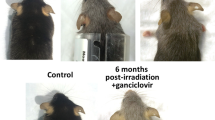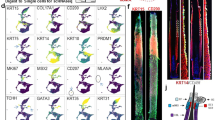Abstract
As one of the earliest and most visible phenomenon of aging, gray hair makes it a unique model system for investigating the mechanism of aging. Ionizing radiation successfully induces gray hair in mice, and also provides a venue to establish an organ-cultured human gray hair model. To establish a suitable organ-cultured human gray HF model by IR, which imitates gray hair in the elderly, and to explore the mechanisms behind the model. By detecting growth parameters, melanotic and senescence markers of the model, we found that the model of 5 Gy accords best with features of elderly gray hair. Then, we investigated the formation mechanisms of the model by RNA-sequencing. We demonstrated that the model of organ-cultured gray HFs after 5 Gy irradiation is closest to the older gray HFs. Moreover, the 5 Gy inhibited the expression of TRP-1, Tyr, Pmel17, and MITF in hair bulbs/ORS of HFs. The 5 Gy also significantly induced ectopically pigmented melanocytes and increased the expression of DNA damage and senescence in HFs. Finally, RNA-seq analysis of the model suggested that IR resulted in cell DNA damage, and the accumulation of oxidative stress in the keratinocytes. Oxidative stress and DNA damage caused cell dysfunction and decreased melanin synthesis in the gray HFs. We found that HFs irradiated at 5 Gy successfully constructed an appropriate aging HF model. This may provide a useful model for cost-effective and predictable treatment strategies to human hair graying and the process of aging.







Similar content being viewed by others
Data availability
The data that support the findings of this study have been deposited in Gene Expression Omnibus with the accession code: https://www.ncbi.nlm.nih.gov/geo/query/acc.cgi.acc=GSE193386.
References
Panhard S, Lozano I, Loussouarn G. Greying of the human hair: a worldwide survey, revisiting the “50” rule of thumb. Br J Dermatol. 2012;167:865–73.
Keogh EV, Walsh RJ. Rate of greying of human hair. Nature. 1965;207:877–8.
Mendelsohn AR, Larrick JW. The Danger of Being Too Sympathetic: Norepinephrine in Alzheimer’s Disease and Graying of Hair. Rejuvenation Res. 2020;23:68–72.
Juceviciute N, Banaityte I, Vaitkus A, Balnyte R. Preclinical signs of Parkinson’s disease: A possible association of Parkinson’s disease with skin and hair features. Med Hypotheses. 2019;127:100–4.
ElFaramawy AAA, Hanna IS, Darweesh RM, Ismail AS, Kandil HI. The degree of hair graying as an independent risk marker for coronary artery disease, a CT coronary angiography study. Egypt Heart J. 2018;70:15–9.
Nishimura EK, Granter SR, Fisher DE. Mechanisms of hair graying: incomplete melanocyte stem cell maintenance in the niche. Science. 2005;307:720–4.
Nishimura EK. Melanocyte stem cells: a melanocyte reservoir in hair follicles for hair and skin pigmentation. Pigment Cell Melanoma Res. 2011;24:401–10.
Commo S, Gaillard O, Bernard BA. Human hair greying is linked to a specific depletion of hair follicle melanocytes affecting both the bulb and the outer root sheath. Br J Dermatol. 2004;150:435–43.
Inomata K, et al. Genotoxic stress abrogates renewal of melanocyte stem cells by triggering their differentiation. Cell. 2009;137:1088–99.
Zhang B, et al. Hyperactivation of sympathetic nerves drives depletion of melanocyte stem cells. Nature. 2020;577:676–81.
Riley T, Sontag E, Chen P, Levine A. Transcriptional control of human p53-regulated genes. Nat Rev Mol Cell Biol. 2008;9:402–12.
Aoki H, Hara A, Motohashi T, Kunisada T. Keratinocyte stem cells but not melanocyte stem cells are the primary target for radiation-induced hair graying. J Invest Dermatol. 2013;133:2143–51.
Oh JW, et al. A Guide to Studying Human Hair Follicle Cycling In Vivo. J Invest Dermatol. 2016;136:34–44.
Rachmin I, et al. Stress-associated ectopic differentiation of melanocyte stem cells and ORS amelanotic melanocytes in an ex vivo human hair follicle model. Exp Dermatol. 2021;30:578–87.
Arck PC, et al. Towards a “free radical theory of graying”: melanocyte apoptosis in the aging human hair follicle is an indicator of oxidative stress induced tissue damage. FASEB J. 2006;20:1567–9.
Peters EM, et al. Profiling mRNA of the graying human hair follicle constitutes a promising state-of-the-art tool to assess its aging: an exemplary report. J Invest Dermatol. 2013;133:1150–60.
Poeggeler B, Bodo E, Nadrowitz R, Dunst J, Paus R. A simple assay for the study of human hair follicle damage induced by ionizing irradiation. Exp Dermatol. 2010;19:e306-309.
Van Neste D, Tobin DJ. Hair cycle and hair pigmentation: dynamic interactions and changes associated with aging. Micron. 2004;35:193–200.
Association WM. World Medical Association Declaration of Helsinki Ethical Principles for Medical Research Involving Human Subjects. JAMA. 2013;310:2191–4.
Philpott MP, Green MR, Kealey T. Human hair growth in vitro. J Cell Sci. 1990;97(Pt 3):463–71.
Ito T, et al. Interferon-gamma is a potent inducer of catagen-like changes in cultured human anagen hair follicles. Br J Dermatol. 2005;152:623–31.
Schneider MR, Schmidt-Ullrich R, Paus R. The hair follicle as a dynamic miniorgan. Curr Biol. 2009;19:R132-142.
Kloepper JE, et al. Methods in hair research: how to objectively distinguish between anagen and catagen in human hair follicle organ culture. Exp Dermatol. 2010;19:305–12.
Peters E, et al. Control of human hair growth by neurotrophins: brain-derived neurotrophic factor inhibits hair shaft elongation, induces catagen, and stimulates follicular transforming growth factor beta2 expression. J Invest Dermatol. 2005;124:675–85.
Dodt HU, et al. Ultramicroscopy: three-dimensional visualization of neuronal networks in the whole mouse brain. Nat Methods. 2007;4:331–6.
Adema GJ, Bakker AB, de Boer AJ, Hohenstein P, Figdor CG. pMel17 is recognised by monoclonal antibodies NKI-beteb, HMB-45 and HMB-50 and by anti-melanoma CTL. Br J Cancer. 1996;73:1044–8.
O’Sullivan JDB, et al. The biology of human hair greying. Biol Rev Camb Philos Soc. 2021;96:107–28.
Commo S, Bernard BA. Melanocyte subpopulation turnover during the human hair cycle: an immunohistochemical study. Pigment Cell Res. 2000;13:253–9.
Tobin DJ, Paus R. Graying: gerontobiology of the hair follicle pigmentary unit. Exp Gerontol. 2001;36:29–54.
Hoashi T, et al. Glycoprotein nonmetastatic melanoma protein b, a melanocytic cell marker, is a melanosome-specific and proteolytically released protein. FASEB J. 2010;24:1616–29.
Horikawa T, et al. DOPA-negative melanocytes in the outer root sheath of human hair follicles express premelanosomal antigens but not a melanosomal antigen or the melanosome-associated glycoproteins tyrosinase, TRP-1, and TRP-2. J Invest Dermatol. 1996;106:28–35.
Slominski A, et al. Hair follicle pigmentation. J Invest Dermatol. 2005;124:13–21.
Lee JH, Fisher DE. Melanocyte stem cells as potential therapeutics in skin disorders. Expert Opin Biol Ther. 2014;14:1569–79.
Shi Y, et al. Premature graying as a consequence of compromised antioxidant activity in hair bulb melanocytes and their precursors. PLoS ONE. 2014;9: e93589.
Ressler S, et al. p16INK4A is a robust in vivo biomarker of cellular aging in human skin. Aging Cell. 2006;5:379–89.
Niedernhofer LJ, et al. Nuclear Genomic Instability and Aging. Annu Rev Biochem. 2018;87:295–322.
Lopez-Otin C, Blasco MA, Partridge L, Serrano M, Kroemer G. The hallmarks of aging. Cell. 2013;153:1194–217.
Kudlova N, et al. An efficient, non-invasive approach for in-vivo sampling of hair follicles: design and applications in monitoring DNA damage and aging. Aging (Albany NY). 2021;13:25004–24.
Matsumura H, et al. Hair follicle aging is driven by transepidermal elimination of stem cells via COL17A1 proteolysis. Science. 2016;351:aad4395.
Lu Z, et al. Profiling the response of human hair follicles to ultraviolet radiation. J Invest Dermatol. 2009;129:1790–804.
Harris ML, et al. A dual role for SOX10 in the maintenance of the postnatal melanocyte lineage and the differentiation of melanocyte stem cell progenitors. PLoS Genet. 2013;9: e1003644.
Harris ML, et al. A direct link between MITF, innate immunity, and hair graying. PLoS Biol. 2018;16: e2003648.
Stone RC, Aviv A, Paus R. Telomere Dynamics and Telomerase in the Biology of Hair Follicles and their Stem Cells as a Model for Aging Research. J Invest Dermatol. 2021;141:1031–40.
Kaur K, Kaur R, Bala I. Therapeutics of premature hair graying: A long journey ahead. J Cosmet Dermatol. 2019. https://doi.org/10.1111/jocd.13000.
Jo SK, et al. Three Streams for the Mechanism of Hair Graying. Ann Dermatol. 2018;30:397–401.
Kurita K, et al. Suppression of progressive loss of coat color in microphthalmia-vitiligo mutant mice. J Invest Dermatol. 2005;125:538–44.
Chang S, et al. Essential role of limiting telomeres in the pathogenesis of Werner syndrome. Nat Genet. 2004;36:877–82.
Stout R, Birch-Machin M. Mitochondria's Role in Skin Ageing. Biology (Basel). 2019;8
Kauser S, Westgate GE, Green MR, Tobin DJ. Human hair follicle and epidermal melanocytes exhibit striking differences in their aging profile which involves catalase. J Invest Dermatol. 2011;131:979–82.
Wood JM, et al. Senile hair graying: H2O2-mediated oxidative stress affects human hair color by blunting methionine sulfoxide repair. FASEB J. 2009;23:2065–75.
Pruche F, Kermici M, Prunieras M. Changes in glutathione content in human hair follicle keratinocytes as a function of age of donor: relation with glutathione dependent enzymes. Int J Cosmet Sci. 1991;13:117–24.
Di Micco R, Krizhanovsky V, Baker D, d’Adda di Fagagna F. Cellular senescence in ageing: from mechanisms to therapeutic opportunities. Nat Rev Mol Cell Biol. 2021;22:75–95.
Taylor CT, Colgan SP. Regulation of immunity and inflammation by hypoxia in immunological niches. Nat Rev Immunol. 2017;17:774–85.
Acknowledgements
We greatly appreciate the valuable technical support from Yan-wei Xu PhD, Xiao-xiong Zhou PhD, Jia-rui Zhang PhD and Yu-yang Gan PhD. We also would like to thank Editage (www.editage.cn) for English language editing.
Funding
This study was supported by the National Natural Science Foundation of China (Grant 81701929, No.81971889, No.81902013, No.82103763), the Natural Science Foundation of Guangdong Province (Grant No.2019A1515012170, Grant No.2020A1515110700). We also like to acknowledge all the patients and volunteers who have kindly contributed samples.
Author information
Authors and Affiliations
Contributions
All the authors agree with the contents of the manuscript and to have it published. Da-mao Dai: conceptualization, methodology, writing—review and editing, resources, formal analysis, project administration, investigation. Ye He & Qing Guan: Conceptualization, methodology, formal analysis, data curation, writing–original draft, visualization, investigation. Zhe-xiang Fan & Yun-min Zhu: Data Curation, Formal analysis, Resources, Investigation, Writing—Original Draft. Jin Wang: Conceptualization, validation, and investigation. Shu-lian Wu & Jian Chen: Data curation and formal analysis. De-meng-jie Le: Methodology and visualization. Zhi-qi Hu: Funding acquisition, supervision, writing, review, and editing. Qian Qu & Yong Miao: Funding acquisition, supervision, project administration, writing, review, and editing.
Corresponding authors
Ethics declarations
Conflict of interest
The authors declare no competing interests.
Additional information
Publisher's Note
Springer Nature remains neutral with regard to jurisdictional claims in published maps and institutional affiliations.
Supplementary Information
Below is the link to the electronic supplementary material.
About this article
Cite this article
Dai, Dm., He, Y., Guan, Q. et al. Modeling human gray hair by irradiation as a valuable tool to study aspects of tissue aging. GeroScience 45, 1215–1230 (2023). https://doi.org/10.1007/s11357-022-00592-6
Received:
Accepted:
Published:
Issue Date:
DOI: https://doi.org/10.1007/s11357-022-00592-6




